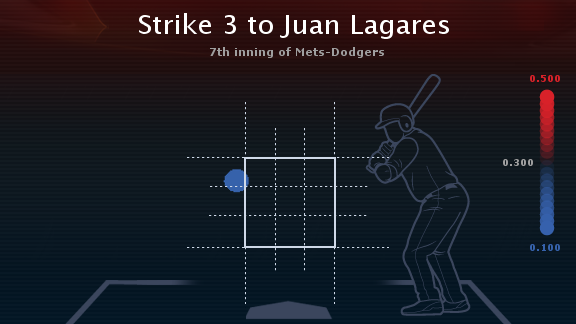It was clearly a turning point in last night’s game. Juan Lagares was at the plate with the bases loaded and one out in the Met’s seventh inning and the tying run only 90 feet away. First, with the count at 2-0, Lagares was charged with a strike when the first base umpire ruled he had not adequately checked his swing on an inside fastball.
The young Met centerfielder battled fouling off several pitchers before drawing ball three to run the count full. Dodger reliever Ronald Belisario then delivered a pitch clearly outside the strike zone and also arguably high. The home plate umpire failed to move a muscle as the ball smacked the catcher’s glove.
Lagares, sure the pitch was way outside (it was), stepped across the plate and took his first two steps toward first base. It was then the home plate umpire lifted his fist and punched out the young Met outfielder.
“I got a full count, bases loaded, and am looking for something I can make a good swing on,” Lagares said. “No chance at that pitch. That’s what I said plate umpire Chad Fairchild. I just said, ‘No chance.'”

What did Fairchild reply?
“I didn’t hear anything,” Lagares said postgame. “I just walked to the dugout. In that situation, that’s the at-bat right there. I just saw the replay right now. For me, it’s outside. But there’s nothing you can do about that. It’s something that’s going to happen.”
I’m not sure if it’s umpire insecurity or arrogance but more often than not a home plate umpire will call out batters with delayed third strike calls when a batter begins his route to first base on a 3-2 pitch that is clearly out of the strike zone before the umpire has called ball four. The younger and less experienced a batter the more likelihood the punch out will be assessed.
This phenomenon is common in a Double-A Eastern League game. B-Met first baseman Allan Dykstra has an excellent eye at the plate. Dykstra has drawn more base-on-balls than any other player in the Eastern League, 92, ten walks ahead of Jamie Johnson, a centerfielder from Erie.
Several times this year I have watched Dykstra take a three ball pitch that appeared off the plate. Dykstra sort of leans in with a pitch toward the outside part of the plate, then, certain the pitch is a ball, stoops down and begins to unstrap an ankle guard he wears on his lead foot. Every time this scenario is repeated, the umpire calls a delayed strike.
Right or wrong a home plate umpire’s ball/strike call always stands. It would be prudent to instruct young players to take an extra second until the umpire makes the call. With an additional second or two, a home plate umpire should never feel upstaged. Ball four is a free pass to first base, so there should be no rush to get there.
Sometimes the smallest things in a baseball game can make a huge difference.














